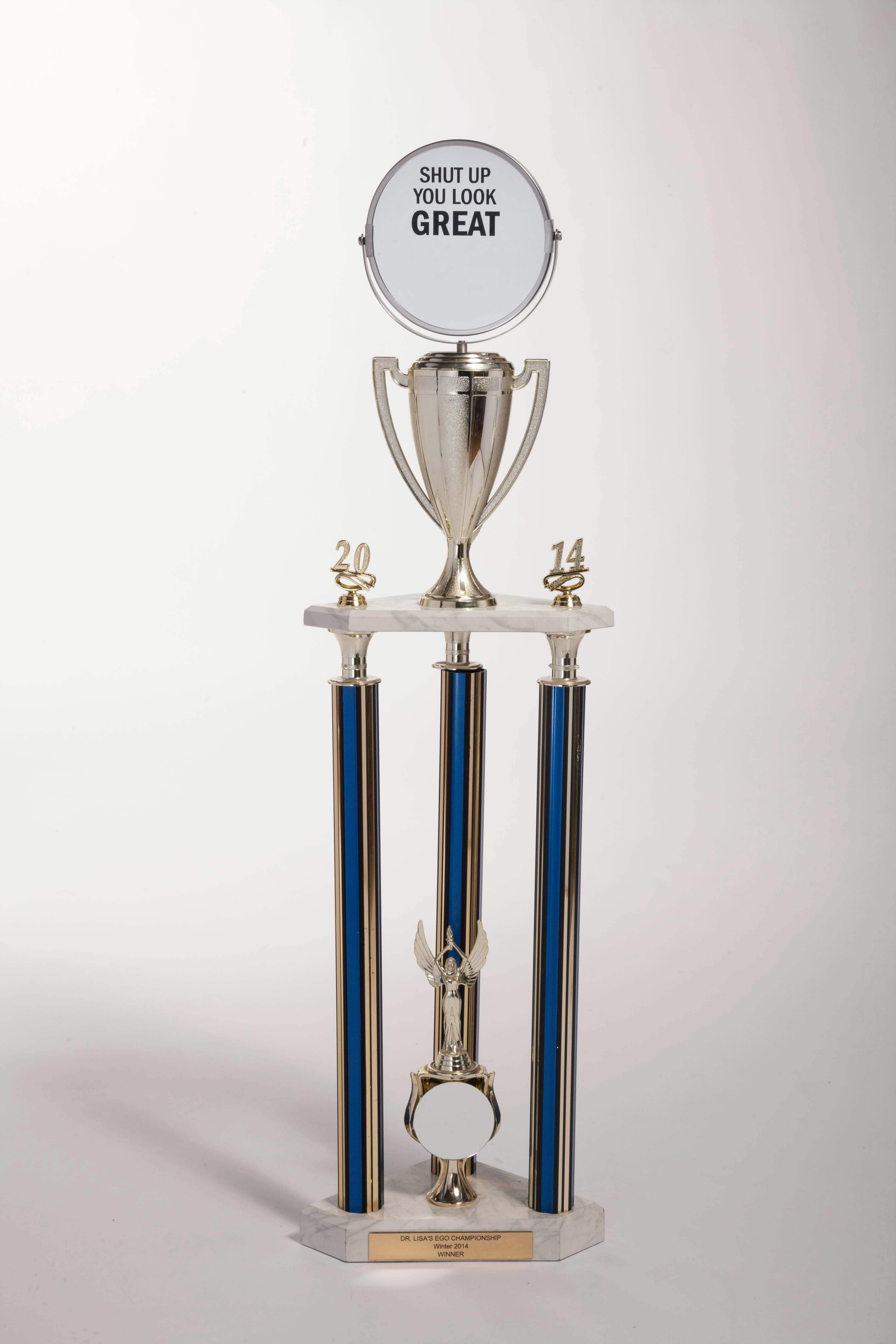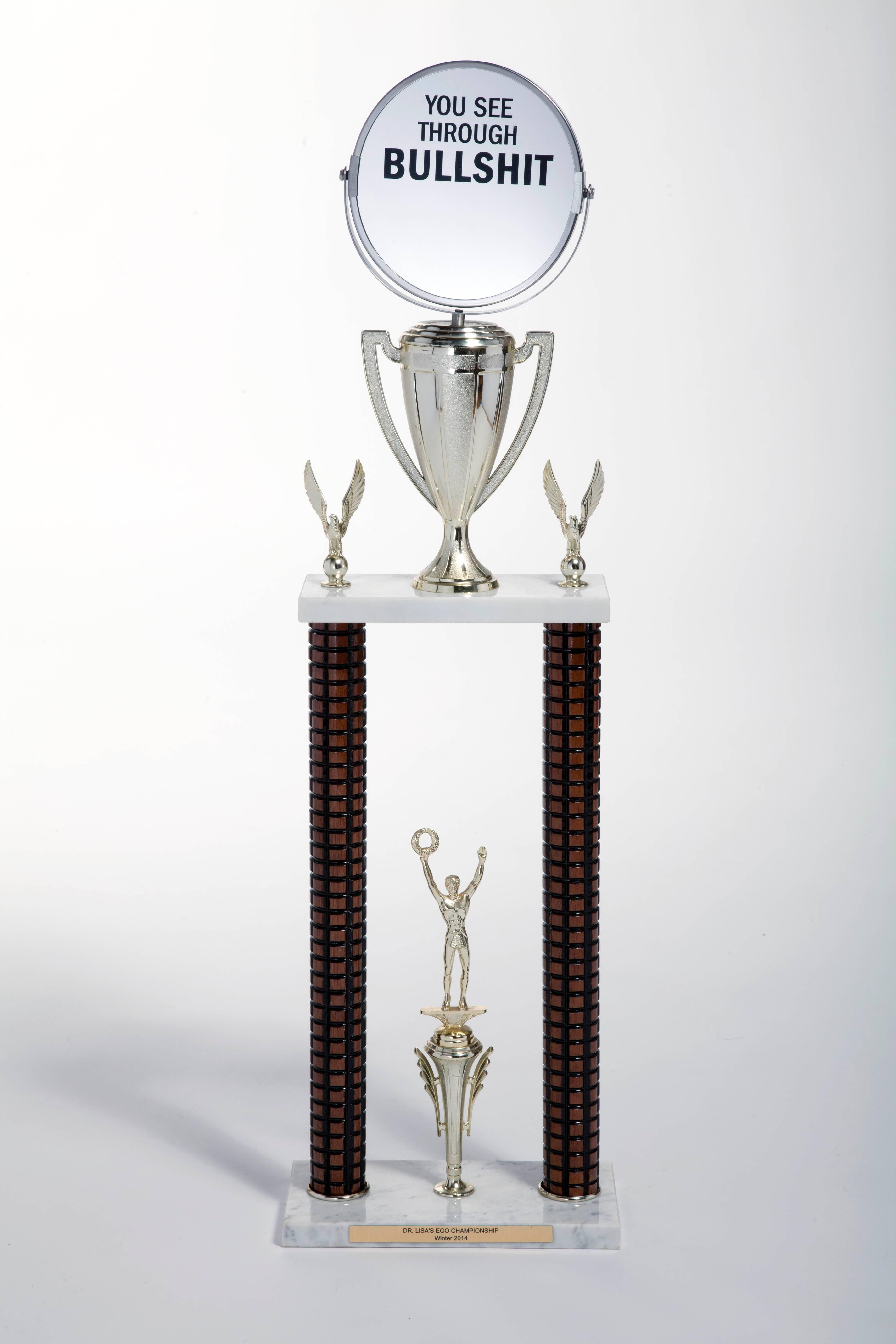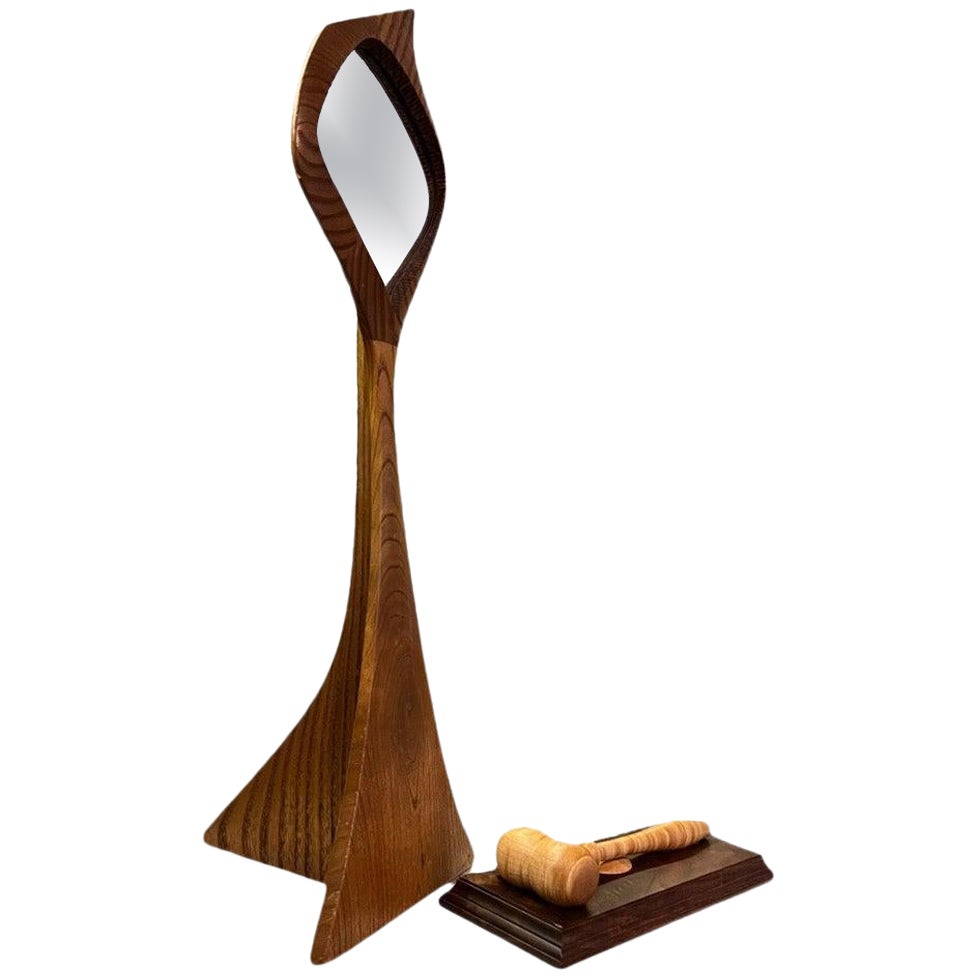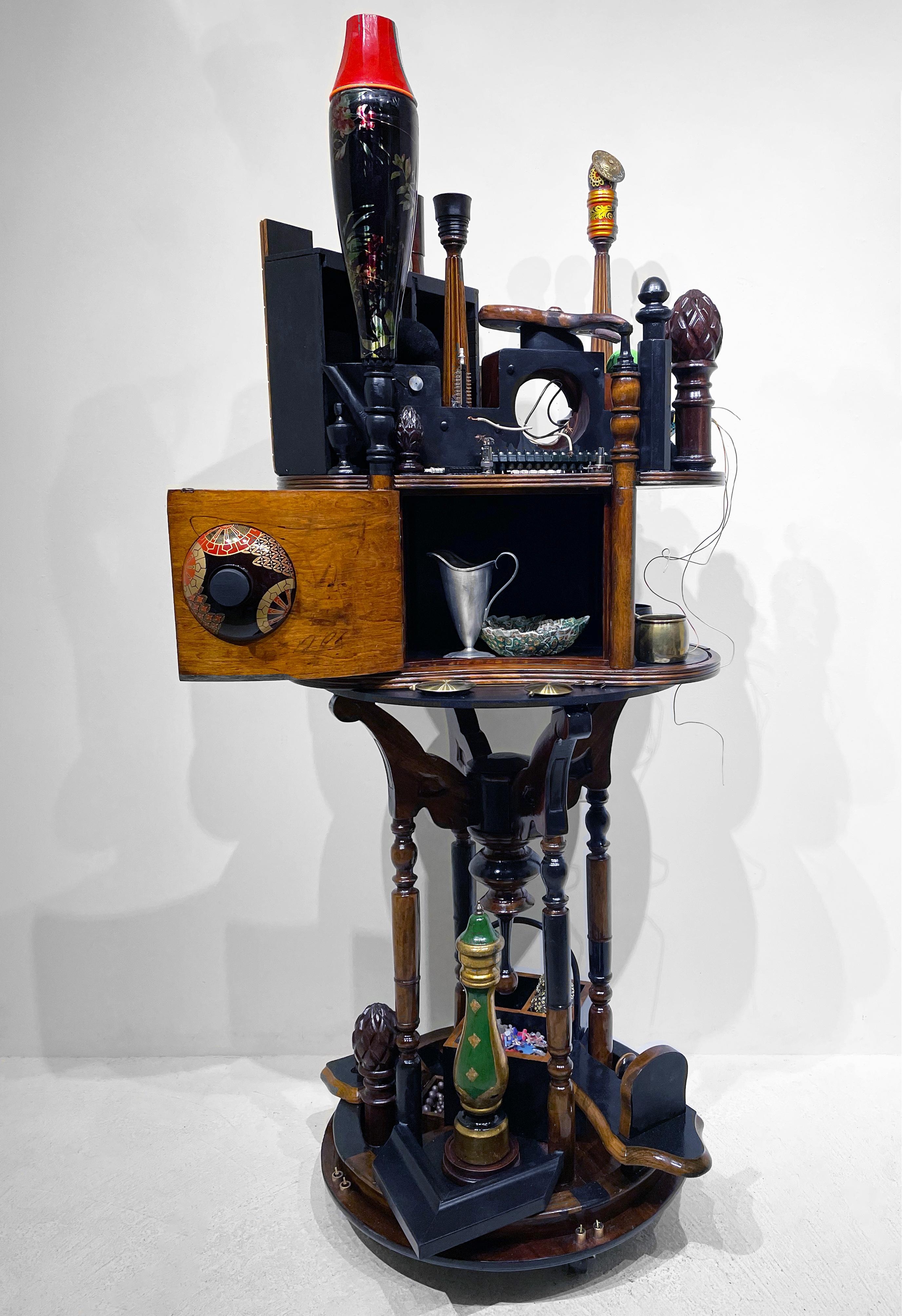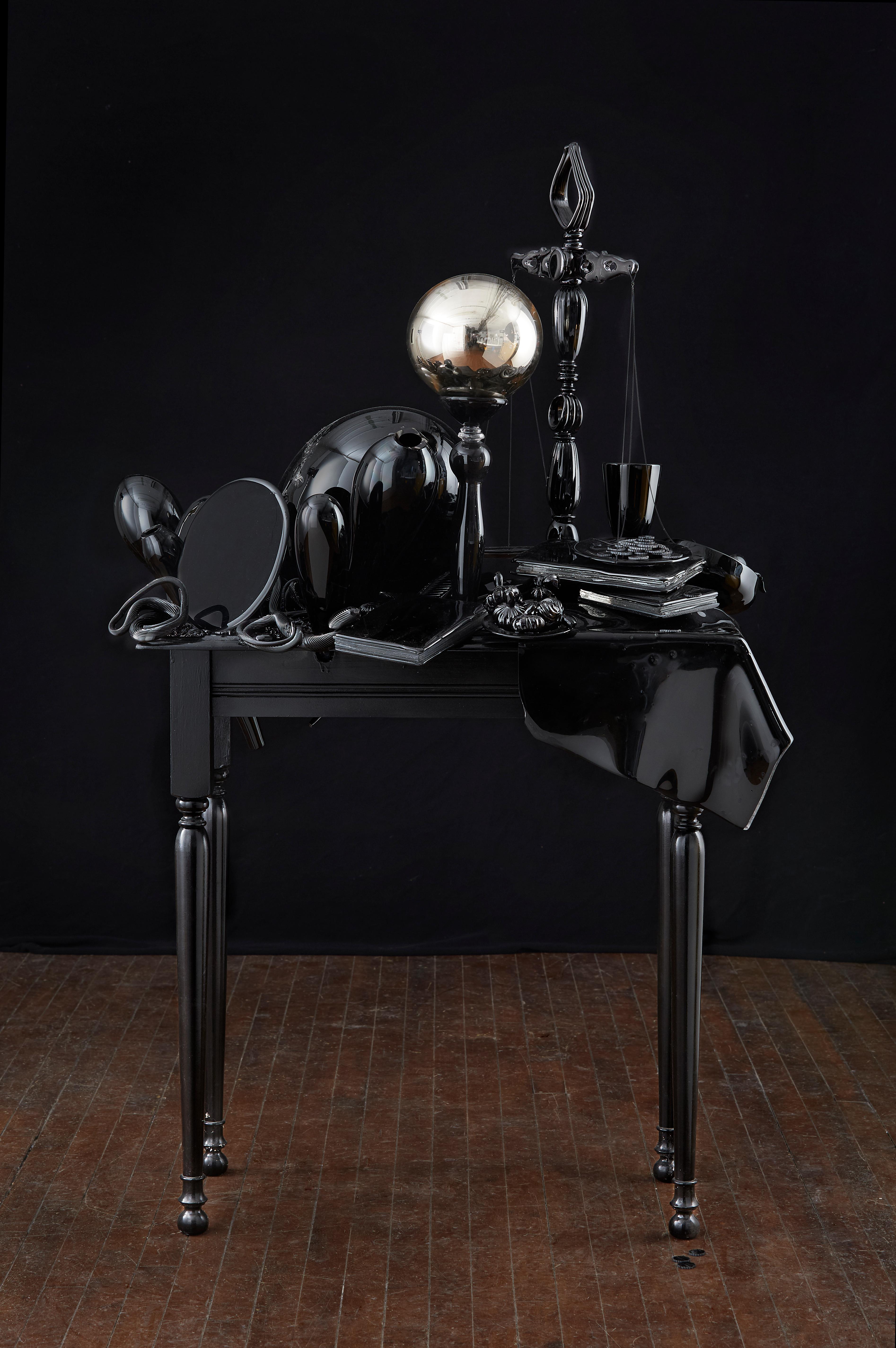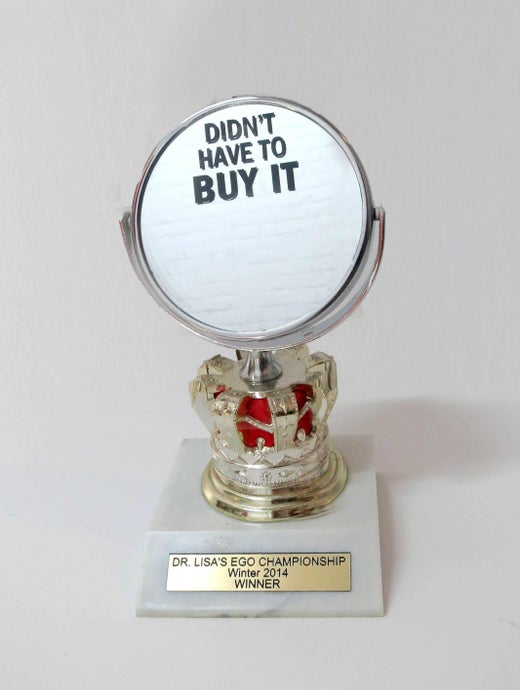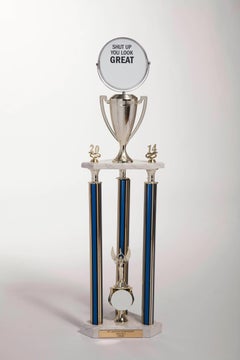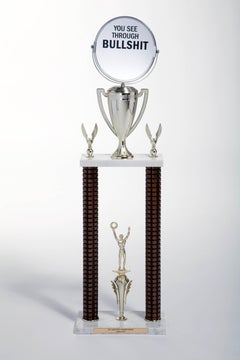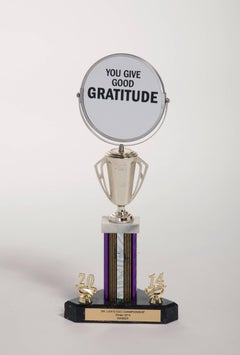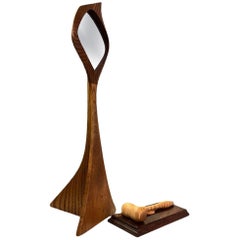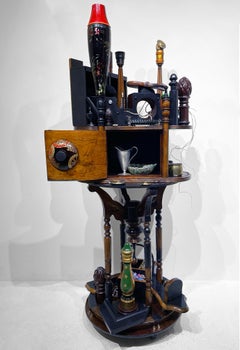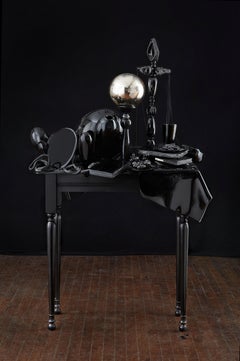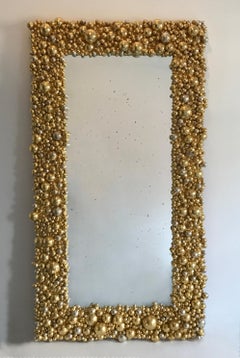Items Similar to Lisa Levy, Didn't Have to Buy It, Mirror, Plastic, Marble, Found Objects
Want more images or videos?
Request additional images or videos from the seller
1 of 5
Lisa LevyLisa Levy, Didn't Have to Buy It, Mirror, Plastic, Marble, Found Objects2014
2014
$600
£454.95
€525.46
CA$841.84
A$937.79
CHF 494.67
MX$11,370.96
NOK 6,292.89
SEK 5,862.23
DKK 3,923.84
About the Item
Dr. Lisa's Ego Championship Trophies
Lisa Levy is a painter, conceptual artist, comedian and (self-proclaimed) psychotherapist.
Lisa's visual career started when she was 3 1/2 when she was sent to the children's art school at MOMA. Before devoting herself fulltime to her art, she had a career as an art director in advertising. Her visual art has been widely exhibited at many venues including White Columns, Artists Space, The Bronx Museum, The New Museum, Schroeder and Romero Gallery and the Scope Art Fair
She also performs live; her most popular character is Dr. Lisa, S.P. (self-proclaimed) who psychoanalyzes people on stage. Besides having all sorts of audience volunteers and comedians, Lisa has had celebrity guests such as Joseph Gordon-Levitt, Michael Musto and Sara Schaefer. She has performed in countless venues, including The Brooklyn Museum, The Edinburgh International Fringe Festival and Joe's Pub.
Lisa has had feature stories about her work in The New York Times, "A Shrink with Stage Presence...", The London Times "Riotously Funny...", Time Out New York, The Huffington Post and Psychology Tomorrow Magazine. She is currently the advice columnist for The Bushwick Daily.
In addition to making her own art, Lisa is always looking for different ways to use her creativity. She has won an Absolut Vodka photography contest with a photo from a photo booth; and a Hebrew National Salami advertising contest, garnering the top prize of $83,000 and a spot on David Letterman's Stupid Pet Tricks with her hamster that bowled. She also has many other strange, random television appearances that she has orchestrated behind the scenes on The Today Show, VH1, The People's Court and more.
- Creator:Lisa Levy (American)
- Creation Year:2014
- Dimensions:Height: 7 in (17.78 cm)Width: 3.5 in (8.89 cm)Depth: 3.5 in (8.89 cm)
- Medium:
- Movement & Style:
- Period:
- Condition:Dr. Lisa's Ego Championship Trophies can be customized to fit your ego needs.
- Gallery Location:Darien, CT
- Reference Number:1stDibs: LU1722946363
Lisa Levy
Lisa Levy is a painter, conceptual artist, comedian and (self-proclaimed) psychotherapist. She also performs live; her most popular character is Dr. Lisa, S.P. (self-proclaimed) who psychoanalyzes people on stage. Besides having all sorts of audience volunteers and comedians, Lisa has had celebrity guests such as Joseph Gordon-Levitt, Michael Musto and Sara Schaefer. She has performed in countless venues, including The Brooklyn Museum, The Edinburgh International Fringe Festival and Joe's Pub.
About the Seller
5.0
Vetted Professional Seller
Every seller passes strict standards for authenticity and reliability
Established in 2014
1stDibs seller since 2015
143 sales on 1stDibs
- ShippingRetrieving quote...Shipping from: Darien, CT
- Return Policy
Authenticity Guarantee
In the unlikely event there’s an issue with an item’s authenticity, contact us within 1 year for a full refund. DetailsMoney-Back Guarantee
If your item is not as described, is damaged in transit, or does not arrive, contact us within 7 days for a full refund. Details24-Hour Cancellation
You have a 24-hour grace period in which to reconsider your purchase, with no questions asked.Vetted Professional Sellers
Our world-class sellers must adhere to strict standards for service and quality, maintaining the integrity of our listings.Price-Match Guarantee
If you find that a seller listed the same item for a lower price elsewhere, we’ll match it.Trusted Global Delivery
Our best-in-class carrier network provides specialized shipping options worldwide, including custom delivery.More From This Seller
View AllLisa Levy, Shut Up You Look Great, 2014, Mirror, Plastic, Marble, Found Objects
By Lisa Levy
Located in Darien, CT
Dr. Lisa's Ego Championship Trophies
Lisa Levy is a painter, conceptual artist, comedian and (self-proclaimed) psychotherapist.
Lisa's visual career started when she was 3 1/2 ...
Category
21st Century and Contemporary Assemblage Still-life Sculptures
Materials
Marble
Lisa Levy, You See Through Bullshit, 2014, Mirror, Plastic, Marble, Found Object
By Lisa Levy
Located in Darien, CT
Dr. Lisa's Ego Championship Trophies
Lisa Levy is a painter, conceptual artist, comedian and (self-proclaimed) psychotherapist.
Lisa's visual career started when she was 3 1/2 ...
Category
21st Century and Contemporary Assemblage Still-life Sculptures
Materials
Marble
Lisa Levy, You Give Good Gratitude, 2014, Mirror, Plastic, Marble, Found Objects
By Lisa Levy
Located in Darien, CT
Dr. Lisa's Ego Championship Trophies
Lisa Levy is a painter, conceptual artist, comedian and (self-proclaimed) psychotherapist.
Lisa's visual career started when she was 3 1/2 ...
Category
21st Century and Contemporary Assemblage Still-life Sculptures
Materials
Marble
Richard Klein, Expo 67, 2017, Found and altered objects assemblage
Located in Darien, CT
In the mid 1990s Richard Klein started working with found glass objects, including bottles, drinking glasses, ashtrays, and eyeglasses. Initially, Klein rejected any object with commercial or advertising content, but in 2015 he became fascinated with the promotional content that was screen printed on ashtrays from the 1950s, 1960s and early 1970s. This period was before smoking was looked at as being primarily a negative habit, and iconic American businesses, including Howard Johnson’s, International House of Pancakes (iHop) and Holiday Inn, all produced promotional ashtrays printed with their graphic identity.
By the time Klein became interested in these objects, the businesses had either ceased to exist, or had changed their logos, and many of their signature buildings, which where examples of classic, “Pop” roadside architecture, has been torn down or repurposed. The artist wanted to connect the glass objects with the business’s sites that were still recognizable and spoke of their history, so he began researching where original buildings still stood.
Klein then embarked on a series of road trips to photograph these sites with the intention of combining the photographs with the promotional glass objects. This led him to as far south as Maryland and as far north as upstate New York from his home in Connecticut.
In the case of Holiday Inn, it wasn’t their buildings, but their iconic illuminated sign that appeared on ashtrays, so he sought out a standing example of the sign he could photograph.
As it turned out all had been removed years before from the hotels' properties and the only working example was indoors at the Henry Ford Museum in Dearborn, Michigan. He did, however, find out that there was one still standing, surprisingly, in Beruit, Lebanon. He found an image of it on the web and used it to make Holiday Inn (Beruit).
In 1973 Holiday Inn changed their tagline from “The Nations Innkeeper” to “The World’s Innkeeper” as they expanded overseas, including the Mideast. For the hotel chain it was bad timing: the disastrous Lebanese civil war began in 1975. In the war, the different Lebanese militias involved in the conflict, including the Nasserites, Christian Phalangists, and the Lebanese National Movement engaged in what came to be called “The Battle of the Hotels” where they each occupied a major high-rise hotel in central Beruit. The Phalangists commanded the Holiday Inn, which they used to fire with both light arms and heavier weapons at the militias in neighboring hotels.
Klein used the photo of the heavily damaged Holiday Inn sign as I thought it spoke in a curious, offhanded way about American cultural imperialism in juxtaposition with an ashtray that proclaimed Holiday Inn to be “The World’s Innkeeper.” In the work Holiday Inn (Nocturne) the artist utilized a found, 35mm slide of a Holiday Inn sign at night at an unknown location as the basis of the photograph in the work.
Richard Klein is a Connecticut-based artist, independent curator and writer. As an artist, he has exhibited widely, including the Neuberger Museum of Art at SUNY Purchase; Caren Golden Fine Art, New York; the John Michael Kohler Arts Center, Sheboygan, WI; Hales Gallery, London; Gavlak Gallery, Palm Beach, FL; deCordova Sculpture Park and Museum, Lincoln, MA; James Barron Art, Kent, CT; The Portland Institute of Contemporary Art (PICA), Portland, OR; Schoolhouse Gallery, Provincetown, MA; Stephan Stoyanov Gallery, NY; Katonah Museum of Art, Katonah, NY; Brattleboro Museum and Art Center, Brattleboro, VT; Ortega y Gasset Projects, Brooklyn, NY; Exhibit by Alberson Tulsa, OK; Incident Report/Flow Chart Foundation, Hudson, NY; ICEHOUSE Project Space, Sharon, CT; Kenise Barnes Fine Art in Kent, CT and with ODETTA Gallery at the Equity Gallery in New York City..
Reviews of his work have appeared in Two Coats of Paint, Whitehot Magazine, The New York Times, Sculpture Magazine, Art in America, and The New Yorker. In the summer of 2024 he will be the first Artist-In-Residence at Peck Ledge Light...
Category
2010s Assemblage Still-life Sculptures
Materials
Metal
Richard Klein, Holiday Inn Nocturne, 2020, Found and altered objects assemblage
Located in Darien, CT
In the mid 1990s Richard Klein started working with found glass objects, including bottles, drinking glasses, ashtrays, and eyeglasses. Initially, Klein rejected any object with commercial or advertising content, but in 2015 he became fascinated with the promotional content that was screen printed on ashtrays from the 1950s, 1960s and early 1970s. This period was before smoking was looked at as being primarily a negative habit, and iconic American businesses, including Howard Johnson’s, International House of Pancakes (iHop) and Holiday Inn, all produced promotional ashtrays printed with their graphic identity.
By the time Klein became interested in these objects, the businesses had either ceased to exist, or had changed their logos, and many of their signature buildings, which where examples of classic, “Pop” roadside architecture, has been torn down or repurposed. The artist wanted to connect the glass objects with the business’s sites that were still recognizable and spoke of their history, so he began researching where original buildings still stood.
Klein then embarked on a series of road trips to photograph these sites with the intention of combining the photographs with the promotional glass objects. This led him to as far south as Maryland and as far north as upstate New York from his home in Connecticut.
In the case of Holiday Inn, it wasn’t their buildings, but their iconic illuminated sign that appeared on ashtrays, so he sought out a standing example of the sign he could photograph.
As it turned out all had been removed years before from the hotels' properties and the only working example was indoors at the Henry Ford Museum in Dearborn, Michigan. He did, however, find out that there was one still standing, surprisingly, in Beruit, Lebanon. He found an image of it on the web and used it to make Holiday Inn (Beruit).
In 1973 Holiday Inn changed their tagline from “The Nations Innkeeper” to “The World’s Innkeeper” as they expanded overseas, including the Mideast. For the hotel chain it was bad timing: the disastrous Lebanese civil war began in 1975. In the war, the different Lebanese militias involved in the conflict, including the Nasserites, Christian Phalangists, and the Lebanese National Movement engaged in what came to be called “The Battle of the Hotels” where they each occupied a major high-rise hotel in central Beruit. The Phalangists commanded the Holiday Inn, which they used to fire with both light arms and heavier weapons at the militias in neighboring hotels.
Klein used the photo of the heavily damaged Holiday Inn sign as I thought it spoke in a curious, offhanded way about American cultural imperialism in juxtaposition with an ashtray that proclaimed Holiday Inn to be “The World’s Innkeeper.” In the work Holiday Inn (Nocturne) the artist utilized a found, 35mm slide of a Holiday Inn sign at night at an unknown location as the basis of the photograph in the work.
Richard Klein is a Connecticut-based artist, independent curator and writer. As an artist, he has exhibited widely, including the Neuberger Museum of Art at SUNY Purchase; Caren Golden Fine Art, New York; the John Michael Kohler Arts Center, Sheboygan, WI; Hales Gallery, London; Gavlak Gallery, Palm Beach, FL; deCordova Sculpture Park and Museum, Lincoln, MA; James Barron Art, Kent, CT; The Portland Institute of Contemporary Art (PICA), Portland, OR; Schoolhouse Gallery, Provincetown, MA; Stephan Stoyanov Gallery, NY; Katonah Museum of Art, Katonah, NY; Brattleboro Museum and Art Center, Brattleboro, VT; Ortega y Gasset Projects, Brooklyn, NY; Exhibit by Alberson Tulsa, OK; Incident Report/Flow Chart Foundation, Hudson, NY; ICEHOUSE Project Space, Sharon, CT; Kenise Barnes Fine Art in Kent, CT and with ODETTA Gallery at the Equity Gallery in New York City..
Reviews of his work have appeared in Two Coats of Paint, Whitehot Magazine, The New York Times, Sculpture Magazine, Art in America, and The New Yorker. In the summer of 2024 he will be the first Artist-In-Residence at Peck Ledge Light...
Category
2010s Assemblage Still-life Sculptures
Materials
Metal
Richard Klein, Holiday Inn Beirut, 2017, Found and altered objects assemblage
Located in Darien, CT
In the mid 1990s Richard Klein started working with found glass objects, including bottles, drinking glasses, ashtrays, and eyeglasses. Initially, Klein rejected any object with commercial or advertising content, but in 2015 he became fascinated with the promotional content that was screen printed on ashtrays from the 1950s, 1960s and early 1970s. This period was before smoking was looked at as being primarily a negative habit, and iconic American businesses, including Howard Johnson’s, International House of Pancakes (iHop) and Holiday Inn, all produced promotional ashtrays printed with their graphic identity.
By the time Klein became interested in these objects, the businesses had either ceased to exist, or had changed their logos, and many of their signature buildings, which where examples of classic, “Pop” roadside architecture, has been torn down or repurposed. The artist wanted to connect the glass objects with the business’s sites that were still recognizable and spoke of their history, so he began researching where original buildings still stood.
Klein then embarked on a series of road trips to photograph these sites with the intention of combining the photographs with the promotional glass objects. This led him to as far south as Maryland and as far north as upstate New York from his home in Connecticut.
In the case of Holiday Inn, it wasn’t their buildings, but their iconic illuminated sign that appeared on ashtrays, so he sought out a standing example of the sign he could photograph.
As it turned out all had been removed years before from the hotels' properties and the only working example was indoors at the Henry Ford Museum in Dearborn, Michigan. He did, however, find out that there was one still standing, surprisingly, in Beruit, Lebanon. He found an image of it on the web and used it to make Holiday Inn (Beruit).
In 1973 Holiday Inn changed their tagline from “The Nations Innkeeper” to “The World’s Innkeeper” as they expanded overseas, including the Mideast. For the hotel chain it was bad timing: the disastrous Lebanese civil war began in 1975. In the war, the different Lebanese militias involved in the conflict, including the Nasserites, Christian Phalangists, and the Lebanese National Movement engaged in what came to be called “The Battle of the Hotels” where they each occupied a major high-rise hotel in central Beruit. The Phalangists commanded the Holiday Inn, which they used to fire with both light arms and heavier weapons at the militias in neighboring hotels.
Klein used the photo of the heavily damaged Holiday Inn sign as I thought it spoke in a curious, offhanded way about American cultural imperialism in juxtaposition with an ashtray that proclaimed Holiday Inn to be “The World’s Innkeeper.” In the work Holiday Inn (Nocturne) the artist utilized a found, 35mm slide of a Holiday Inn sign at night at an unknown location as the basis of the photograph in the work.
Richard Klein is a Connecticut-based artist, independent curator and writer. As an artist, he has exhibited widely, including the Neuberger Museum of Art at SUNY Purchase; Caren Golden Fine Art, New York; the John Michael Kohler Arts Center, Sheboygan, WI; Hales Gallery, London; Gavlak Gallery, Palm Beach, FL; deCordova Sculpture Park and Museum, Lincoln, MA; James Barron Art, Kent, CT; The Portland Institute of Contemporary Art (PICA), Portland, OR; Schoolhouse Gallery, Provincetown, MA; Stephan Stoyanov Gallery, NY; Katonah Museum of Art, Katonah, NY; Brattleboro Museum and Art Center, Brattleboro, VT; Ortega y Gasset Projects, Brooklyn, NY; Exhibit by Alberson Tulsa, OK; Incident Report/Flow Chart Foundation, Hudson, NY; ICEHOUSE Project Space, Sharon, CT; Kenise Barnes Fine Art in Kent, CT and with ODETTA Gallery at the Equity Gallery in New York City..
Reviews of his work have appeared in Two Coats of Paint, Whitehot Magazine, The New York Times, Sculpture Magazine, Art in America, and The New Yorker. In the summer of 2024 he will be the first Artist-In-Residence at Peck Ledge Light...
Category
2010s Assemblage Still-life Sculptures
Materials
Metal
You May Also Like
1975 American Modern Tabletop Mirror Sculpture by Robert Whitley 'Signed'
By Robert Whitley
Located in North Miami, FL
1975 American modern tabletop mirror and gavel with stand sculptures made of curly maple and walnut by Robert Whitley (1924). Both pieces are carved and signed by the artist.
Meas...
Category
20th Century American Abstract Sculptures
Materials
Wood, Maple, Walnut
Linda Stein, Favorites 1232 - Contemporary Art Mixed Media Assemblage Sculpture
Located in New York, NY
This work from Linda Stein's Displacement From Home series draws from the tradition of wunderkammer/cabinets of curiosities to highlight the global displacement and traumatic memory ...
Category
2010s Contemporary Abstract Sculptures
Materials
Metal
$36,000 Sale Price
20% Off
STILL-LIFE WITH SCALE AND GAZING BALL
By Beth Lipman
Located in New York, NY
black glass sculpture on a wood table depicting a scale and a gazing ball.
Price includes travel and installation by the artist.
work is currently in an ex...
Category
2010s Contemporary Still-life Sculptures
Materials
Metal
Price Upon Request
Large Mirror Sculpture; 'Sphere Mirror'
By Kelly Bugden + Van Wifvat
Located in New York, NY
The artistic collaboration of Kelly Bugden + Van Wifvat has produced a thought-provoking body of sculptures, paintings, and constructions. Nature, childhood memories, and everyday archetypes take shape in unexpected combinations of materials. The works emerged as the tactile and visual senses channeled the ritualistic power and materiality of selected artifacts. The resulting objects exist in a space between what they were originally and what they could become. A wheel, for example, is distorted as if seen through a prism. Their collaboration grew out of years of shaping materials into one-of-a-kind objects. Intuitively, the process of creating with their hands took an inward turn. Prism is a travelogue through memories and dreams, yielding abstract forms that capture moments of transformation.
Van Wifvat grew up with eight siblings and studied sculpture and environmental design in Minneapolis at MCAD. In 1979, he opened a storefront art gallery to promote the work of local artists. The space featured printed materials—art books, periodicals, fanzines, and postcard’s. Wifvat moved to New York in 1983 to study at the Fashion Institute of Technology and Parsons. In 1987, he co-founded Van Gregory & Norton design studio, specializing in convex mirrors and curtain hardware...
Category
2010s Abstract Abstract Sculptures
Materials
Gold Leaf
Swedish Modern Sculptural Mirror by Stig Carlsson 1970s
By Stig Carlsson
Located in Örebro, SE
Cool and rare sculpture/mirror, possibly unique by Stig Carlsson.
Stig Carlsson was a swedish sculptor/designer. During his early career he was an appre...
Category
Vintage 1970s Swedish Table Mirrors
Materials
Stoneware, Mirror
British Contemporary Sculpture by Phiip Hearsey - Second Chance
By Philip Hearsey
Located in Paris, IDF
Unique
Bronze freely rotating on a scorched yew base
Stamped with monogram signature and uniquely numbered 561A
The natural bronze ends of the ring are finely rubbed and lacquered.
W...
Category
2010s Contemporary Abstract Sculptures
Materials
Bronze
More Ways To Browse
Sculpture Marble Children
Marble David Sculpture
Marble Sculpture Of David
Vintage Moulin Rouge Dancers
Vintage Travel Posters Texas
Vintage Yellow Oil Lamp
Windsor Castle Oil Landscape
Wolf Kahn Purple
1980 Swatch Watch
Al Loving
Alligator Chest
Andre Gisson
Antique Animal Traps
Antique Laundry Sign
Antique Millstones
Antique Raphael Tuck
Antonio Luna
Barbara Bailey
